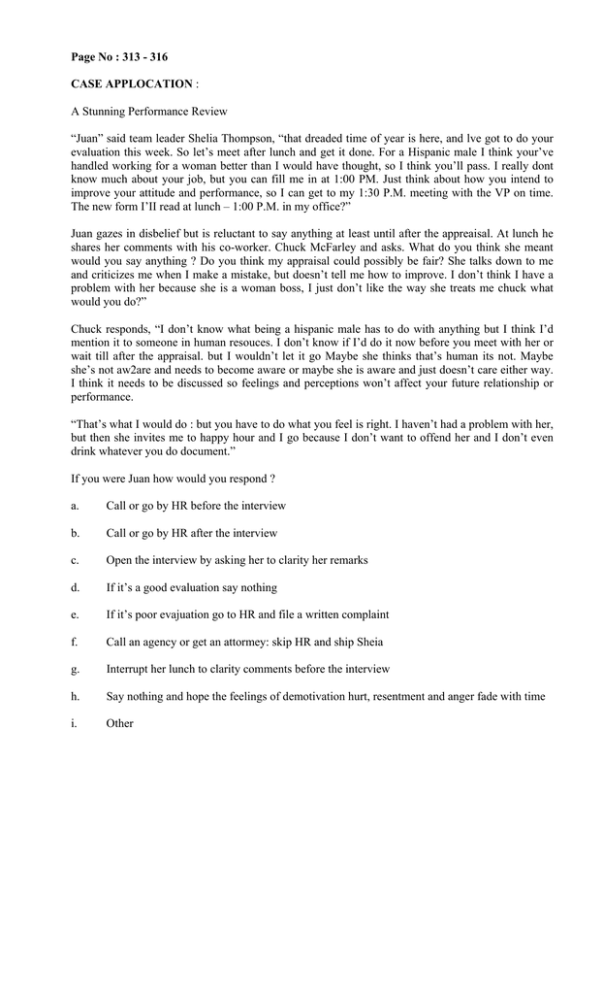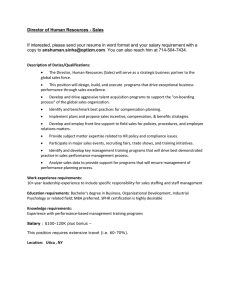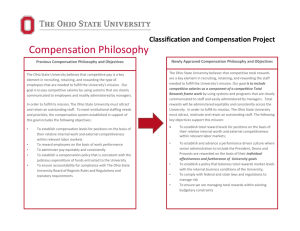Page No : 313 - 316 CASE APPLOCATION A Stunning Performance Review
advertisement

Page No : 313 - 316 CASE APPLOCATION : A Stunning Performance Review “Juan” said team leader Shelia Thompson, “that dreaded time of year is here, and lve got to do your evaluation this week. So let’s meet after lunch and get it done. For a Hispanic male I think your’ve handled working for a woman better than I would have thought, so I think you’ll pass. I really dont know much about your job, but you can fill me in at 1:00 PM. Just think about how you intend to improve your attitude and performance, so I can get to my 1:30 P.M. meeting with the VP on time. The new form I’II read at lunch – 1:00 P.M. in my office?” Juan gazes in disbelief but is reluctant to say anything at least until after the appreaisal. At lunch he shares her comments with his co-worker. Chuck McFarley and asks. What do you think she meant would you say anything ? Do you think my appraisal could possibly be fair? She talks down to me and criticizes me when I make a mistake, but doesn’t tell me how to improve. I don’t think I have a problem with her because she is a woman boss, I just don’t like the way she treats me chuck what would you do?” Chuck responds, “I don’t know what being a hispanic male has to do with anything but I think I’d mention it to someone in human resouces. I don’t know if I’d do it now before you meet with her or wait till after the appraisal. but I wouldn’t let it go Maybe she thinks that’s human its not. Maybe she’s not aw2are and needs to become aware or maybe she is aware and just doesn’t care either way. I think it needs to be discussed so feelings and perceptions won’t affect your future relationship or performance. “That’s what I would do : but you have to do what you feel is right. I haven’t had a problem with her, but then she invites me to happy hour and I go because I don’t want to offend her and I don’t even drink whatever you do document.” If you were Juan how would you respond ? a. Call or go by HR before the interview b. Call or go by HR after the interview c. Open the interview by asking her to clarity her remarks d. If it’s a good evaluation say nothing e. If it’s poor evajuation go to HR and file a written complaint f. Call an agency or get an attormey: skip HR and ship Sheia g. Interrupt her lunch to clarity comments before the interview h. Say nothing and hope the feelings of demotivation hurt, resentment and anger fade with time i. Other Juan decides to say nothing until after the apprasal is over, then he will ask her what she meant by the comments, how he perceived it, felt and what he would like in the future. When he shows up for the interview, she says, “come in.” “Hey, I checked everything average, because I don’t think anyone is perfect and if I gave you an excellent 5 rating. You wouldn’t understand when I would ask you to improve or do more, better, or faster. Almost everyone is getting average. I’d like a better than average is getting average. I’d like a better than average team, but some of us would have to try harder and take instruction better, wouldn’t we ? OK, sign at the bottom and I’ll give it to the vice president when I see him in a minute. We’ll talk more tomorrow, Don’t be discouraged : the vice president is a Hispanic male”. Stunned again, Juan does not want to sign the form but is on his way to human resoucres to formal complaint against Shelia. Assignment If you were the HR representative assigned to coach Shelia on the appraisal process. When are at least ten suggestions you would share with her ? TESTING YOUR UNDERSTANDING How well did you fulfill the learning objectives ? 1. Performance management systems lead to employee motivation in all of these ways except a. Work objective are clarified b. Criteria for measuring work objectives are specified c. Employees have confidence that their efforts will lead to satisfactory job performance d. Employees have confidence that satisfactory job performance will lead to an acceptable reward e. Individual value systems are identified 2. A directory of direct purchase accounts always has trouble with his people after performance appraisals. They quit call in sick for a week or sabotage operations. During a conversation with Rhonda the vice president of human resources the director complained about the performance evaluation process. “I have a bunch of babies working for me. They all expect me to tell them what good performance is Part of their job is figuring out what they are supposed to do.” What would be the best response from Rhonda? a. Sympathize Agree that the director’s employees are babies. b. Help the director develop corrective action steps for his employees c. Tell the director that performance standards should be set with employees and objectives should be clearly agreed to d. Tell the director to set clear performance expectations for his employees. It is job, not theirs e. Show the director the director the performance objectives rhoda uses for her employees. Suggest that the director use those objectives 3. Mare is a marketing analyst. His boss periodically observes his work on specific parts of his job (client) calls, conducting meetings, attending seminars, etc) and writes down, using specific behavioral descriptions, what she sees him doing. What appraisal technique is she using? a. graphic rating scale b. critical incident c. BARS d. checklist appraisal e. forced choice comparison 4. Compare the group order ranking and the individual ranking techniques for performance evaluation a. The techniques are the same b. Individual ranking is disadvantaged because you may be forced to identity the “best of the best” in one set of employees and the “best of the best” in one set of employees and the “best of the worst” in another set. Group order ranking does not have this problem c. Group order ranking is disadvantaged because you may be forced to identity the “best of the best” in one set of employees and the “best of the west” in another set. Individual ranking does not have this problem d. Individual ranking forces the evaluator to compare all employees to each other Group order ranking does not e. Individual ranking allows no ties. Group order ranking allows ties 5. If you had an MBO agreement with your professor about what to do to get an A in this class, which would be the best (in terms of MBO standard) objective? a. Get an A for doing the best you can b. Get an a for excellent work on tests, quizzes, and projects c. Get an a for score of 90 or better on this test d. Get an A for interesting contributions to class e. Get an a if you are in the better part of the class 6. Tommy rates admin an average worker, “excellent” on all of his performance evaluations. The rest of staff suspects that Adam gets high ratings because he graduated from the same prestigious university and was a member of the same fraternity as Tommy. If this were accurate, when rating error has the staff identified? a. Similarity error b. Halo error c. Leniency error d. Central tendency e. Inflationary pressures 7. According to attribution theory, if in a supervisor’s judgment an employee’s poor performance is attributable to external factors. a. the employee will be more harshly rated b. the employee will be favorably rated c. the supervisor’s perception will be jaded by impression management influence d. there exists an internal focus of control e. the poor performance will be viewed in more positive terms 8. Which of the following is an example of an upward appraisal ? a. A manager refers to earlier performance appraisals of subordinates before evaluating them. b. peer evaluation is employed. c. Several managers from terms to evaluate all their employees collectively. d. Diminishes the effect of development in the performance appraisal process. e. All the above. 10. Samantha, vice president of a large transnational firm, explains that because of cultural and language differences between the parent and most subsidiary countries, her organization has chosen to evaluate performance only “by the numbers” Gross sales figures and factory productivity levels are used. What is wrong with this approach ? a. Nothing. Most firms are using this technique for international performance evaluation. b. Each country’s accounting practices must be considered when recording sales. (For example, some countries record consignments as sales.) c. Language differences affect factory productivity levels. 11. d. Sales figures cannot be easily converted to a common currency designation. e. The effort is redundant. Either gross sales or factory productivity levels should be sufficient. Good performance management systems are designed to provide a. Performance information and salary updates. b. disciplinary action and salary updates. c. Feedback, development, and documentation. d. Training, documentation, and salary updates. e. Communication and documentation. 12. Performance management systems must satisfy the needs of a. employees, appraisers, organizations. b. employees, customers, supervisions. c. Customers, managers, human resources professionals. d. employees, organizations, customers. e. Human resources professionals, supervisors, managers. 13. The three approaches for performance appraisal are a. absolute standards, tangential standards, nominal standards. b. absolute standards, relative standards, objectives. c. Absolute standards, objectionable standards, peer review. d. Absolute standards, relatives standards, peer review. e. Relative standards, peer review objectives. 14. MBOs are likely to be ineffective in a. global organizations b. hierarchical organizations that are implementing TQM c. service-sector organizations d. manufacturing plans with more than production facilities. e. Hierarchical organizations in which managers traditionally do not trust subordinates and do not delegate. 15. Advantages of MBO include all of the following except. a. employees have greater commitment to objectives they set. b. employees know what is expected of them. c. MBO provides a basis for performance evaluation. d. MBO is a time-saving way to set goals. e. Employees know that performance is defined in terms of successfully meeting stated objectives. 16. Under which condition should an expatriate be evaluated by the host-country management instead of by parent- country management? a. When the evaluation forms are not properly translated. b. When a hostile cultural environment exists. c. When the home office is so remote that it cannot be fully informed about overseas operations. d. When the economic base of the parent country differs drastically from the host company. e. When the expatriate is from the parent country. Page No : 447 – 349 CASE APPLICATION : Pay for Performance A Pittsburgh based company, Black Box Corporation which markets computer network and other communication devices, developed an innovative solution providing compensation and productivity. After it flattened its organization, management was unable to offer promotions like those offered prior to the flattening. In response the company those offered prior to the flattening. In response the company offered employees the ability to advance them selves in skills and compensation. For example, an order-entry clerk who starts at the $17,000 to $20,000l level can make as much as $35,000 by increasing their value to the company, as measured by a number of objective tests. Pay for performance has worked so well for Black Box Corporation that it has integrated incentives into nearly every aspect of its culture. Black Box uses a system of objective criteria by which management can measure both employee and company performance. Employees are divided into three classes – developmental, competent and premium – according to their impact on the company and are then paid according to a range within those categories as determined by objective evaluations. For example order entry clerk increase their value as they improve their ability to speak to their international customers in their native languages. Black Box monitors and tests clerks on the number of calls they can field and how well they handle them, the number of errors, etc. Each measure comes with pay consequences because each contributes to productivity and customer satisfaction. The company also reimburses 100 percent of tuition for job related course work if the employee can demonstrate competency when the course is completed. Many employees can leap over several pay grades even when they just joined the company. Black Box believes that if someone can perform consistently to the next level of expectation, then they have earned the right to be at the next level and to be compensated accordingly. If employees don’t perform up to the level of their compensation, they can be downgraded, but the company gives them a set period of time to raise their performance. The results are impressive; Black Box has continued to expand the company without increasing its head count. Permission Pending Adapted from Alam Reder, “Pay, 75 Best Business Practices for socially Responsible Companies, Chap 12 G P Putnam’s Sons, 1995. Questions 1. Would you prefer a compensation system as described or a more traditional system, and why? 2. What advantages do you think such a pay for performance system provides? 3. What challenges would such a system face with employees? TESTING YOUR UNDERSTANDING How well did fulfill the learning objectives? 1. Employees respond to organizational rewards for all of these reasons except a. people behave in ways that they believe are in their best interests b. people constantly look for pay offs for their efforts c. people expect that good job performance will lead to organizational goal attainment that will lead to satisfying individual needs or goals 2. d. organizations use rewards to motivate employees e. employees often respond to peer pressure What is the difference between financial and nonfinancial rewards? a. Financial rewards (such as salary) are taxable Nonfinancial rewards (such as daycare spending accounts) rewards tax shelters b. Finance rewards are a matter of public record nonfinacial rewards are not a matter of public record c. job Financial rewards make life better off the job nonfinacial rewards make better on the d. Financial rewards are fixed according to a com pensation scheduale Nonfinacial rewards are variable in nature e. Financial rewards provide the same motivation levels for all employees. Nonfinancial rewards provide differing levels of motivation 3. Good organizational reward systems have all of the following qualities except a. they are individualized to reflected differences in what employees consider important to them 4. b. they are perceived as equitable c. they are visible and flexible d. they are based on seniority e. they are allocated at a relatively low cost Fairness in the context of a compensation system means all of the following except a. a wage adequate for the demands of the job from the organization’s perspective b. employees perception of an appropriate balance in terms of their efforts rewards ratio compared to a relevant standard c. employees perception that they are treated better than similar workers in competing organizations d. pay rates are established according to a jobs comparative worth e. reasonable cost minimization by organizations 5. A compensation analyst for a large firm is completing a job evaluation for her organization identifiable criteria for jobs (skill, effort, responsibility) were determined and points were assigned, based on weighting factors. Several degrees of competency were identified for each of the job criteria. All jobs were then categorized according to these rating scales what job evaluation method was used? a. ordering b. classification c. factor comparison d. point method e. core specification 6. Rachel works for a textile manufacturer as a seamstress. She is paid $0.05 for each sleeve she sews an hour up to 100 sleeves. She is paid $0.09 for each sleeve she produces over the first 100. what kind of compensation system is used? a. piecework b. time saving bonus c. commission d. Scanlon plan e. Improshare 7. Last year an aerospace engineer made $110,000 his annual base pay was $100,000. The remander was calculated based on his ability to faster than the standard hours work. What kind of compensation system was used? 8. a. piecework b. time saving bonus c. commission d. scanlon Plan e. Improshare Competency based compensation systems can best be described as a. paying employees according to knowledge skills, and demonstrated behaviors b. paying employees according to how educated they are and the number of advanced degrees they prossess c. pay systems that promote team based incentives d. incentive systems whereby strategic goals of the organization are replaced by the value added nature of employee skills e. paying employees according to apiecework system a sophisticated formula is used to determine the dollar value of the employees bonus 9. Team based compensation programs reward employees for achieving unit and organizational goals. Under which situation would a team based compensation most likely function well? a. A situation in which a team of workers perform mutually exclusive, independent tasks. b. A situation in which a team of workers have mutual distrust for one another c. A situation where work tasks are woven together such that the work of any one individual is difficult to assess 10. d. A situation in which competition among employees is encouraged and fostered e. A situation in which group values conform to limiting production United states organizations justify high salaries for their executives in all of these ways except a. good decision making ability is not widely represented in the work force b. global competition requires that the United states matches the salaries given to executives in other countries c. organization must pay high prices for scarce executives d. high salaries are necessary are to keep cxcutives from going over to the competition e. high excutive salaries attract good workers throughour managerial levels of an organization 11. Bill a US computer programmer reluctantly moved his family to Saudi Arabia for a three year assignment with his firm. A hardship premium equal to his annual US salary was deposited in a US account for each six months of his assignment. What kind of pay factor was used a. based pay b. differentials c. bonuses d. incentives e. assistance programs 12. All of the following questions should be addressed when considering base pay for expatriates except 13. 14. a. is the cost of living the same in the host country as in the united states? b. will the expatriate pay US or foreign income tax? c. should expatriates be paid in US dollars or local currency? d. are there restrictions on taking money into or out of the host country? e. should salary increases be made according to local standards or US standards? Membership based rewards include all or the following except a. cost of living allowances b. benefit provisions c. pay increases for seniority d. pay increases for completion of a college degree e. commissions compensation administration is a. more heavy influenced by government policies than is strategic human resource planning 15. b. less influenced by government policies than is strategic human resource planning c. less influenced by government policies than is orientation d. influenced at the state, but not the national level e. influenced at the national but not the state level Specific provisions of the fair labor standards act include all of the following except a. child labor laws b. overtime pay of at least 1⅓ times regular pay for all hours worked over forty per week c. some categories of workers such as apprentics or full time students. may be paid less than the minimum wage under special certificates issued by the department of labor d. where federal law differs from state law federal law prevails e. minimum wage and other relevant information must be posted publicly where employees can readily see it 16. pay adjustments designed to maintain the standard of living for an expatriate that she would enjoy at home are called a. base pay b. differntials c. bonuses d. incentive e. assistance programs




